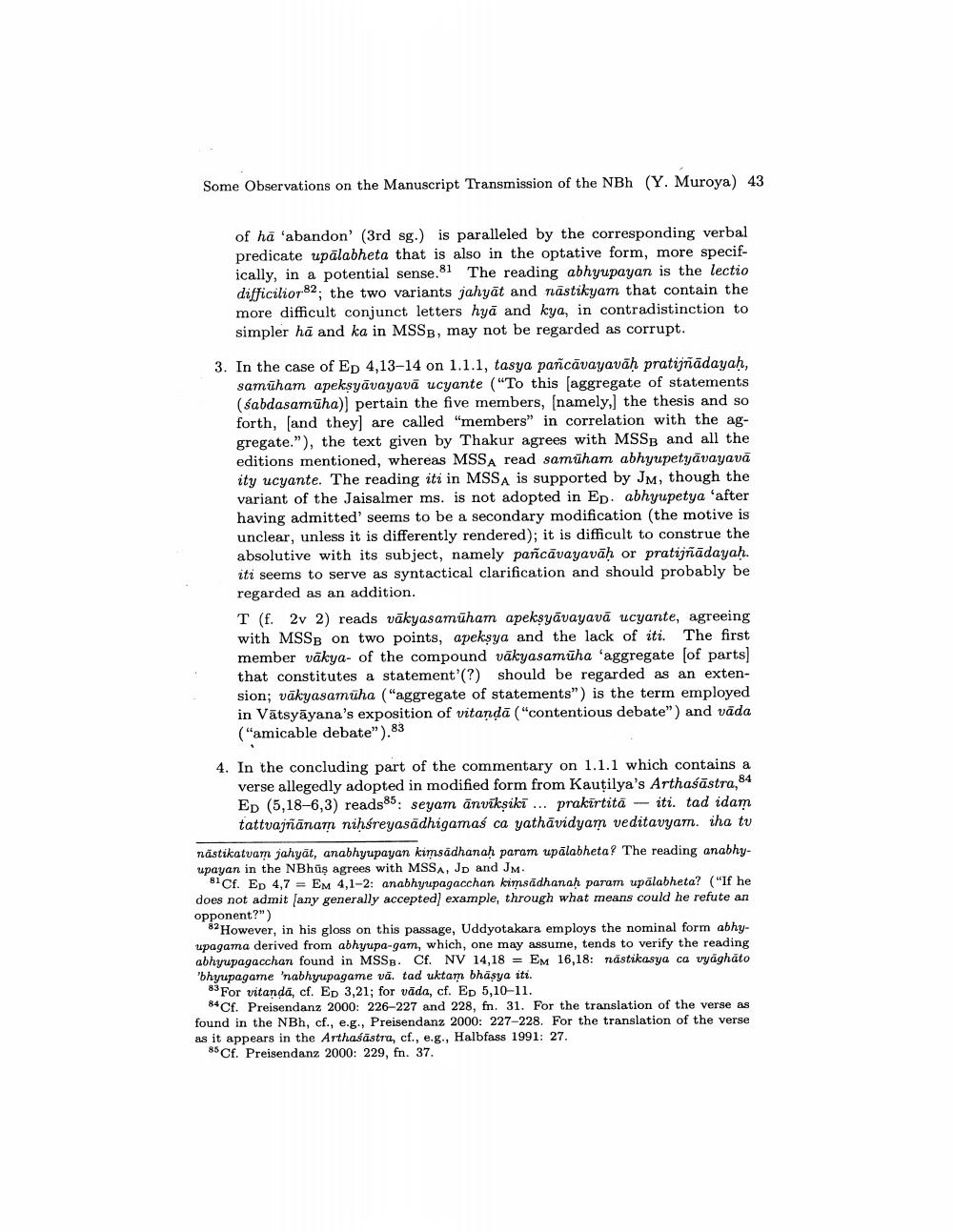________________
Some Observations on the Manuscript Transmission of the NBh (Y. Muroya) 43
of ha 'abandon' (3rd sg.) is paralleled by the corresponding verbal predicate upalabheta that is also in the optative form, more specifically, in a potential sense." 81 The reading abhyupayan is the lectio difficilior 82; the two variants jahyat and nastikyam that contain the more difficult conjunct letters hya and kya, in contradistinction to simpler ha and ka in MSSB, may not be regarded as corrupt.
3. In the case of ED 4,13-14 on 1.1.1, tasya pañcāvayavāḥ pratijñādayaḥ, samuham apekṣyavayavā ucyante ("To this [aggregate of statements (sabdasamuha)] pertain the five members, [namely,] the thesis and so forth, [and they] are called "members" in correlation with the aggregate."), the text given by Thakur agrees with MSSB and all the editions mentioned, whereas MSSA read samuham abhyupetyavayavā ity ucyante. The reading iti in MSSA is supported by JM, though the variant of the Jaisalmer ms. is not adopted in ED. abhyupetya 'after having admitted' seems to be a secondary modification (the motive is unclear, unless it is differently rendered); it is difficult to construe the absolutive with its subject, namely pañcavayavaḥ or pratijñādayaḥ. iti seems to serve as syntactical clarification and should probably be regarded as an addition.
T (f. 2v 2) reads vākyasamuham apekṣyāvayavā ucyante, agreeing with MSSB on two points, apekṣya and the lack of iti. The first member vakya- of the compound vakyasamuha 'aggregate [of parts] that constitutes a statement'(?) should be regarded as an extension; vakyasamüha ("aggregate of statements") is the term employed in Vätsyāyana's exposition of vitanda ("contentious debate") and vāda ("amicable debate").83
4. In the concluding part of the commentary on 1.1.1 which contains a verse allegedly adopted in modified form from Kautilya's Arthasastra,84 ED (5,18-6,3) reads85: seyam anvīkṣiki... prakīrtitā iti. tad idam tattvajñānam nihḥśreyasadhigamaś ca yathavidyam veditavyam. iha tv
nastikatvam jahyat, anabhyupayan kimsadhanaḥ param upalabheta? The reading anabhyupayan in the NBhüş agrees with MSSA, JD and JM.
81Cf. ED 4,7 EM 4,1-2: anabhyupagacchan kimsadhanaḥ param upalabheta? ("If he does not admit [any generally accepted] example, through what means could he refute an opponent?")
82 However, in his gloss on this passage, Uddyotakara employs the nominal form abhyupagama derived from abhyupa-gam, which, one may assume, tends to verify the reading abhyupagacchan found in MSSB. Cf. NV 14,18 EM 16,18: nästikasya ca vyaghato 'bhyupagame 'nabhyupagame va. tad uktam bhāṣya iti.
83 For vitanda, cf. ED 3,21; for vada, cf. ED 5,10-11.
84 Cf. Preisendanz 2000: 226-227 and 228, fn. 31. For the translation of the verse as found in the NBh, cf., e.g., Preisendanz 2000: 227-228. For the translation of the verse as it appears in the Arthasastra, cf., e.g., Halbfass 1991: 27.
85 Cf. Preisendanz 2000: 229, fn. 37.




